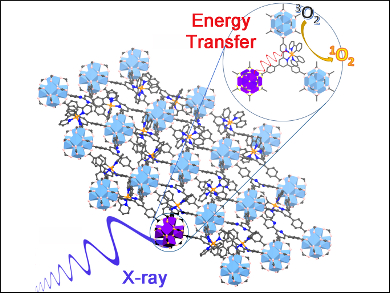Photodynamic therapy (PDT) is an effective anticancer treatment. It uses reactive oxygen species (ROS) generated by a light-activated photosensitizer (PS) to kill cancer cells. Poor light penetration through tissue (<1 cm) limits the applicability of PDT to surface tumors. However, using X-rays with greater depth penetration to activate a PS can extend the range and efficiency of the therapy to larger, deep-seated tumors.
Wenbin Lin, University of Chicago, IL, USA, and colleagues have developed ultrathin nanoscale two-dimensional frameworks, known as metal–organic layers (MOLs), for use in X-ray induced PDT (X-PDT) of colon cancers. Heavy hafnium atom clusters within the MOLs absorb and then transfer X-ray energy to iridium or ruthenium bipyridine-containing PS linkers, where ROS are generated (pictured). The ROS diffuse easily through the ultrathin 2D MOLs (ca. 1.2 nm) into the surrounding tissue.
The researchers injected MOLs into subcutaneous tumors grown on live mice, followed by a course of X-ray irradiation. X-PDT produced an up to 90 % reduction in tumor volumes, suggesting that the technology has great potential for reducing or eradicating aggressive tumors in living organisms.
- Nanoscale Metal-Organic Layers for Deeply Penetrating X-ray-Induced Photodynamic Therapy,
Guangxu Lan, Kaiyuan Ni, Ruoyu Xu, Kuangda Lu, Zekai Lin, Christina Chan, Wenbin Lin,
Angew. Chem. Int. Ed. 2017.
DOI: 10.1002/anie.201704828



